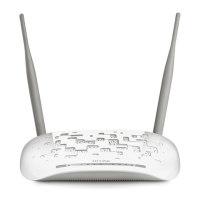37
WEP- 64Bits
To configure WEP-64Bits settings, select the WEP-64Bits option from the drop-down list.
The menu will change to offer the appropriate settings. WEP-64Bits is a data privacy
mechanism based on a 64-bit shared key algorithm, as described in the IEEE 802.11g
standard.
WEP-128Bits
To configure WEP-128Bits settings, select the WEP-128Bits option from the drop-down
list. The menu will change to offer the appropriate settings. 128-bit is stronger than 64-bit.
WPA-PSK
To configure WPA-PSK settings, select the WPA-PSK option from the drop-down list. The
menu will change to offer the appropriate settings. WPA-PSK requires a shared key and
does not use a separate server for authentication. PSK keys can be ASCII or Hex type.
Encryption: Select the encryption you want to use: TKIP/AES, TKIP or AES (AES is an
encryption method stronger than TKIP).
TKIP (
Temporal Key Integrity Protocol) - a wireless encryption protocol that
provides dynamic encryption keys for each packet transmitted.
AES (
Advanced Encryption Standard) - A security method that uses symmetric
128-bit block data encryption.
Pre-Shared Key: Enter the key shared by the modem router and your other network
devices.
WPA2-PSK
To configure WPA2-PSK settings, select the WPA2-PSK option from the drop-down list.
The menu will change to offer the appropriate settings. WPA2-PSK requires a shared key
and does not use a separate server for authentication. PSK keys can be ASCII or Hex type.
WPA-PSK/WPA2-PSK
To configure WPA-PSK/WPA2-PSK settings, select the WPA-PSK/WPA2-PSK option from
the drop-down list. The menu will change to offer the appropriate settings.
WPA-PSK/WPA2-PSK requires a shared key and does not use a separate server for
authentication. PSK keys can be ASCII or Hex type. WPA-PSK/WPA2-PSK is more flexible
than WPA-PSK or WPA2-PSK.
WDS Settings: With this function enabled, the modem router can bridge two or more
WLANs.
WDS Mode: Select On/Off to enable/disable WDS.
WDS Encryption Type: You can select either
AES or TKIP.
WDS Key: Create a key for the router.
MAC Address: Enter the MAC Address you wish to bridge in the field.

